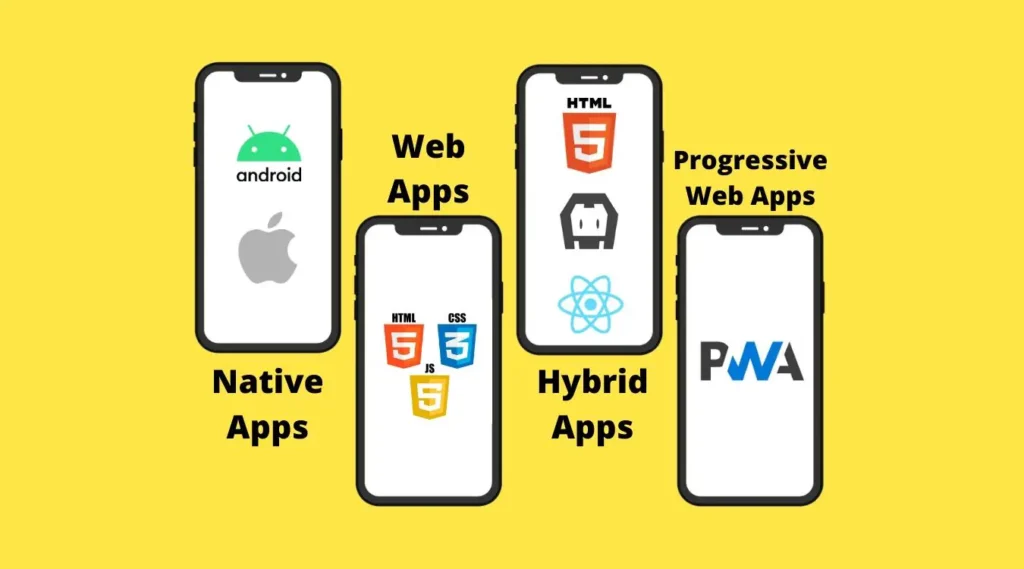As of today, the mobile application market offers a variety of options, categorized into four main types: Native apps, Hybrid apps, Web apps, and Progressive Web Apps (PWAs), each developed and utilized in distinct ways. These classifications reflect the diversity in development approaches and usage scenarios. However, the process of developing mobile applications can be complex due to various factors such as operating system diversity and device compatibility. For instance, creating an Android application may present challenges due to the fragmentation of the Android ecosystem, with numerous device models and versions to consider. Despite these challenges, understanding the differences between these app types can help developers choose the most suitable approach for their projects.
PC:codesnail

Native apps :
Native apps are those which are developed considering a particular OS (eg: ios or android ).So we can not use these apps in any of the devices we want . Whenever the app is being developed using any language like Java, python, kotlin ,flutter or any other language ,these apps are specifically built for specific OS to make the most of the functionalities of the devices that run the particular OS.Native apps are generally built to make the most of all the features and tools of the phones such as contacts, camera, sensors, etc. Native apps ensure a high performance and elegant user experience as the developers use the native device UI to build apps.
Advantages:
- These apps are faster than the other apps, since these are built and use only on one specific os .
- Better Ui/Ux since
- Uses of the device functionalities so less issues of compatibility.
Some examples of Native apps :
Maas360,Uber, Spotify, Instagram
Web-based Mobile apps :
Webapps are the kind of apps which can be accessed through internet sites from a mobile device, it does not require any storage space or memory for the installation .The responsiveness and performance is quite similar to the other apps , but it can not work in a offline mode since we need active internet to access these apps .Web apps are basically a responsive versions of specific websites that work on any device as they are delivered using mobile browsers.
Advantages:
- No installation required hence reduced business cost and maintenance
- Easy to use since it can be accessed from any device
Some examples of webapps :
Trello, slack , Google docs
Hybrid apps:
Hybrid apps are a combination of native and web apps .It can have its icon or logo and be downloaded from an app store directly.Hybrid Apps are built on a single platform and distributed across various app stores such as Google Play store or Apple’s app store similar to Native apps.They have a home screen icon, are built to be responsive, function offline, and even have faster performances than web apps.They can also access device-specific functionalities through plugins or native API calls. However, hybrid apps may not offer the same level of performance and user experience as fully native apps. So native apps have an edge over other apps when it comes to performance.
Advantages:
- Easy to push new features since it uses a single code base.and since it is not OS specific
- Shorter time to market, as the app can be deployed for multiple OSs
Some examples of hybrid apps :
Linkedin, Facebook , Twitter
Progressive web apps (PWA) :
Progressive Web Apps (PWAs) are a type of web application that leverages modern web capabilities to provide a user experience similar to that of native mobile apps. They combine the best features of web and mobile apps to offer advantages such as offline functionality, push notifications, and device hardware access.
Advantages:
- They use very little data – An app which takes close to 10 MBs as a native app, can be reduced to about 500KB when made a PWA.
- Easily can be shared only by sending the URL of the app
- There is no need for installation as PWAs are simple web-pages.
Some examples of PWA :
Twitter Lite,Uber Lite
How to choose which app to go for :
These are a few factors we can consider while choosing which kind of app to for
- Performance and User Experience:
- Evaluate the performance requirements of your app and the desired level of user experience. Native apps typically offer superior performance and seamless integration with device features, providing a smoother user experience.
- Platform Compatibility :
- Consider the platforms you want to target (e.g., iOS, Android, web) and the reach you aim to achieve. Native apps excel in platform-specific features but require separate development for each platform, while hybrid apps and PWAs offer cross-platform compatibility with a single codebase.
- Offline Functionality and Connectivity:
- Determine whether your app needs to function offline or in low-connectivity environments. Native apps with offline capabilities or PWAs are suitable choices for such scenarios, whereas web apps may require continuous internet access to operate.
- Development Time, Cost, and Maintenance:
- Assess your budget, timeline, and available development resources. Native apps typically involve longer development times and higher costs due to platform-specific development, while hybrid apps and PWAs offer cost-effective solutions with quicker development cycles and simplified maintenance.
In conclusion, understanding these distinctions empowers developers to create efficient and user-friendly mobile applications tailored to their specific needs and target audience.
Happy Learning 🙂
 using WordPress and
using WordPress and
No responses yet